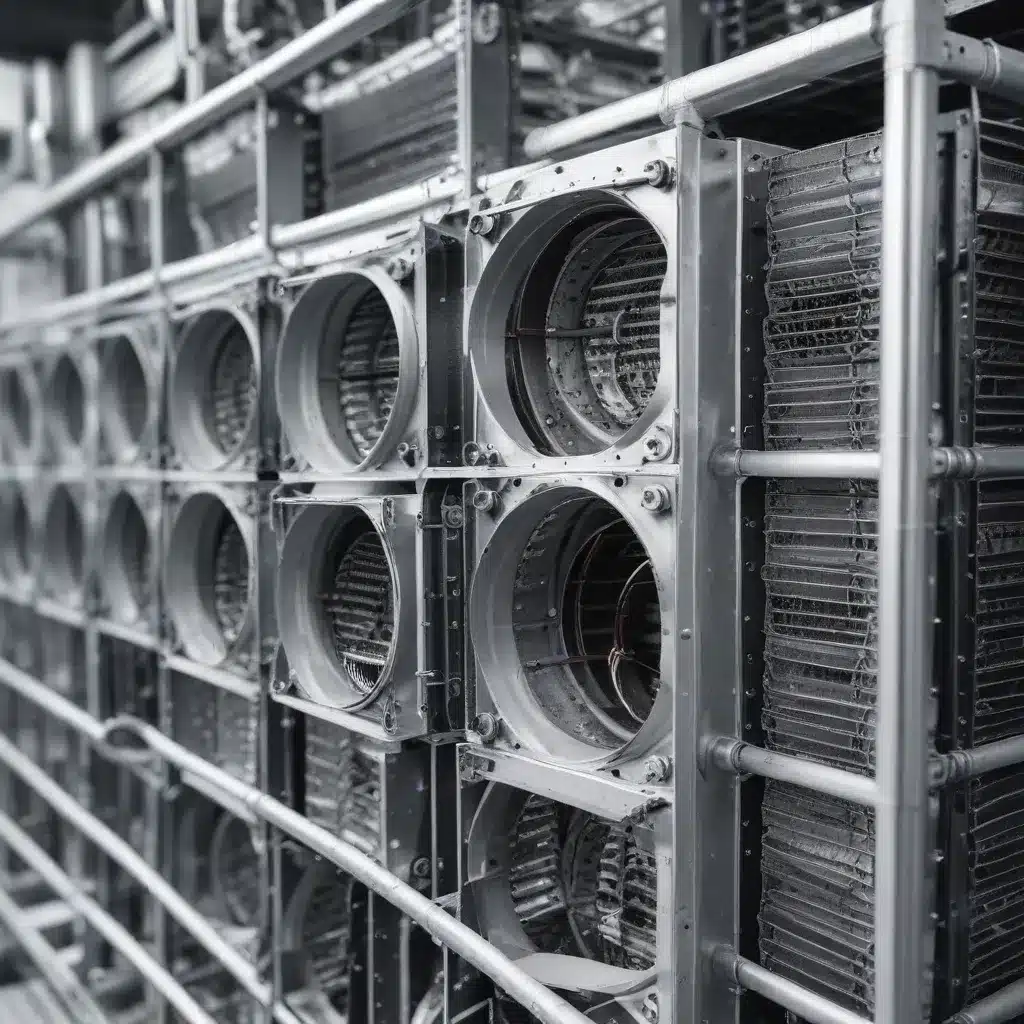
As a seasoned expert in the field of air-cooled heat exchangers, I’m excited to share practical tips and in-depth insights that can help you optimize the performance of these critical heat transfer components. In this article, we’ll explore how the integration of machine learning (ML) techniques can unlock new levels of efficiency and effectiveness in air-cooled heat exchanger design, engineering, and maintenance.
Overcoming the Limits of Traditional Air Cooling
Traditional air-cooling methods, often combined with heat sinks, are beginning to reach their performance limits. To meet the rising thermal management requirements of high-power density electronics, engineers are faced with the need for lower air-supply temperatures and higher air-supply flowrates. This challenge has led to the exploration of alternative cooling solutions, such as single-phase immersion cooling.
Single-Phase Immersion Cooling: Significant Thermal Performance Gains
Single-phase immersion cooling has been shown to provide significant thermal performance improvements and reliability benefits compared to traditional air-cooling. When hardware designed for air cooling is implemented within a single-phase immersion cooling regime, further optimization of the heat sinks can yield additional thermal performance improvements.
Leveraging Machine Learning for Heat Sink Optimization
To address these challenges, researchers have investigated the use of machine learning (ML) approaches to build predictive models for the multi-objective and multi-design variable optimization of air-cooled heat sinks in single-phase immersion cooling applications. By leveraging numerical simulations and a comprehensive dataset, ML algorithms can be trained to accurately predict key performance metrics, such as thermal resistance and pressure drop, as a function of various design inputs.
Parametric Simulations and Data Generation
The first step in this process involves conducting parametric simulations using high-fidelity computational fluid dynamics (CFD) numerical simulations. These simulations consider a range of design variables, including both geometric and material properties, for both forced and natural convection scenarios. The design variables investigated typically include:
- Fin height
- Fin thickness
- Number of fins
- Thermal conductivity of the heat sink material
By systematically varying these parameters, a comprehensive dataset of 864 simulation points was generated, creating a robust data bank for training and evaluating the machine learning models.
Machine Learning Regression Models
Three machine learning regression models were studied to evaluate and compare their performance in accurately predicting heat sink thermal resistance and pressure drop:
-
Polynomial Regression: This model leverages a polynomial function to fit the relationship between the design variables and the performance metrics.
-
Random Forest: This ensemble learning method builds multiple decision trees and combines their outputs to improve the overall predictive accuracy and robustness.
-
Neural Network: The neural network model is a powerful, data-driven approach that can capture complex, non-linear relationships between the design inputs and the heat sink performance.
By training and evaluating these different ML regression models, the researchers were able to identify the most suitable approach for accurately predicting the thermal and hydraulic performance of the air-cooled heat sinks in single-phase immersion cooling applications.
Performance Evaluation and Insights
The machine learning models were assessed based on their ability to accurately predict the heat sink thermal resistance and pressure drop as a function of the design inputs. Key performance metrics, such as R-squared values and mean absolute error, were used to evaluate the models’ predictive accuracy.
The findings from this research indicate that the machine learning-based approach can significantly reduce the design lead time for air-cooled heat sinks in single-phase immersion cooling applications. By leveraging the power of numerical simulations and data-driven modeling, engineers can now explore a wider design space, optimize performance, and rapidly iterate on heat sink designs without the need for extensive physical prototyping and testing.
Advancing Heat Sink Design with Additive Manufacturing
In addition to the machine learning-based optimization techniques, the research also explored the use of electrochemical additive manufacturing (ECAM) to fabricate air-cooled heat sinks with more complex geometries, such as Body Centered Cubic (BCC) lattice structures.
ECAM-Fabricated BCC Lattice Heat Sinks
The ECAM-fabricated BCC lattice heat sinks offer a greater surface area to volume ratio compared to traditional parallel plate fin designs. This increased surface area can potentially enhance the heat transfer performance of the heat sinks in single-phase immersion cooling applications.
To evaluate the thermal performance of these innovative heat sinks, the researchers conducted computational fluid dynamics (CFD) conjugate heat transfer (CHT) analyses. The thermal resistance and pressure drop characteristics of the ECAM-fabricated BCC lattice heat sinks were compared to a baseline finned heat sink design under various dielectric fluid flowrates.
Insights and Future Potential
The findings from this research offer valuable insights into the viability and performance advantages of ECAM-fabricated heat sinks for high-power density electronics immersion cooling applications. By leveraging the design flexibility and surface area enhancements enabled by additive manufacturing, this work contributes to the development of more effective and sustainable cooling solutions for next-generation electronic systems.
Unlocking the Full Potential of Air-Cooled Heat Exchangers
The integration of machine learning-based optimization techniques and the advancements in additive manufacturing-enabled heat sink design represent exciting frontiers in the field of air-cooled heat exchangers. By combining these powerful tools, engineers can unlock new levels of performance, efficiency, and versatility in thermal management solutions.
Whether you’re working on the design, engineering, or maintenance of air-cooled heat exchangers, staying up-to-date with the latest research and innovations in this space can provide a competitive edge. I encourage you to explore the resources available on the Air Cooled Heat Exchangers website to further expand your knowledge and stay ahead of the curve.

